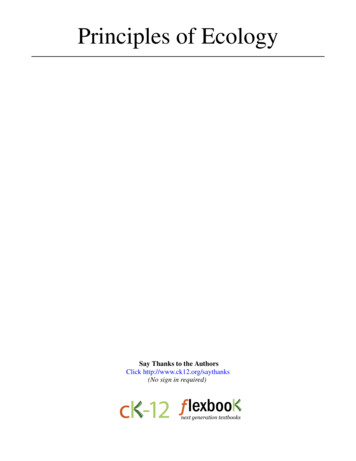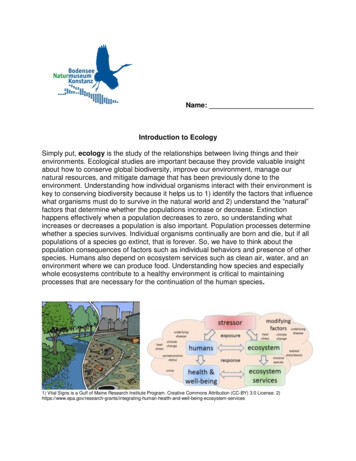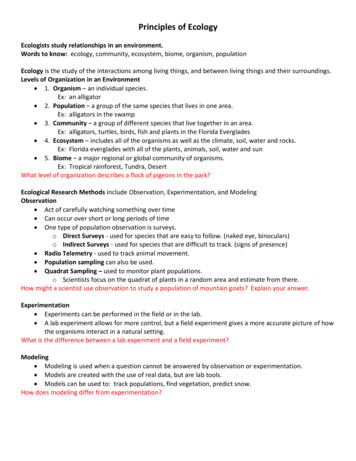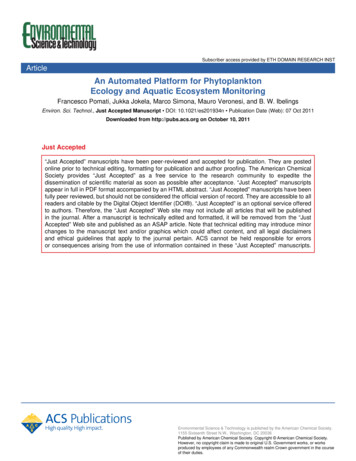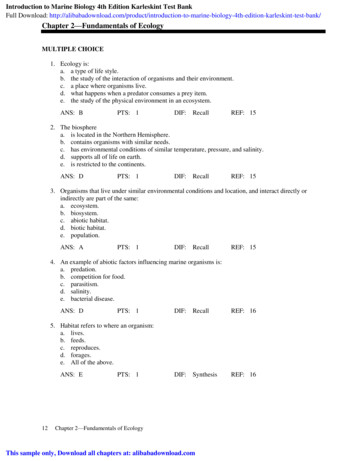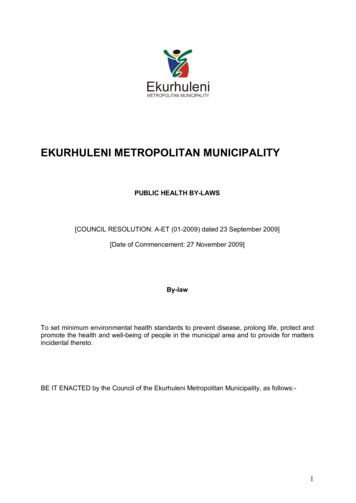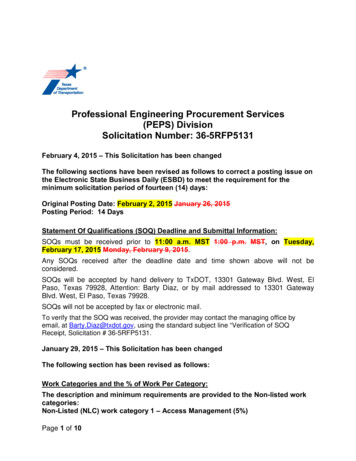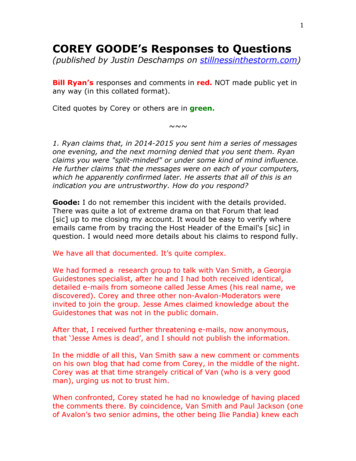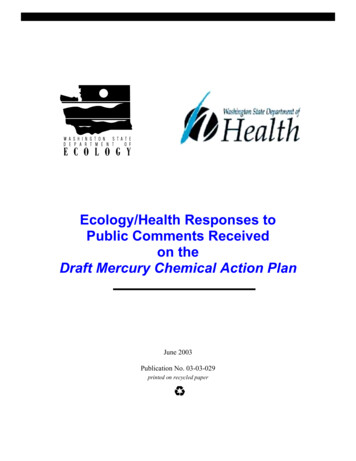
Transcription
Ecology/Health Responses toPublic Comments Receivedon theDraft Mercury Chemical Action PlanJune 2003Publication No. 03-03-029printed on recycled paper
Publication AvailabilityThis document is available on the Department of Ecology home page on the World Wide Web athttp://www.ecy.wa.gov/biblio/0303029.htmlThe Draft for Public Comment: Washington State Mercury Chemical Action Plan is athttp://www.ecy.wa.gov/biblio/0203042.htmlThe final Washington State Mercury Chemical Action Plan is athttp://www.ecy.wa.gov/biblio/0303001.htmlFor printed copies, contact the Publications Office.o For this document, ask for Pub. No. 03-03-029.o For the Draft for Public Comments, ask for Pub. No. 02-03-042.o For the final Washington State Mercury Chemical Action Plan, ask for Pub. No. 03-03-001.Department of Ecology Publications Distributions OfficeAddress: PO Box 47600, Olympia WA 98504-7600E-mail: ecypub@ecy.wa.govPhone: (360) 407-7472Any use of product or firm names in this publication is for descriptive purposes only and doesnot imply endorsement by the author or the Department of Ecology.The Department of Ecology is an equal-opportunity agency and does not discriminate onthe basis of race, creed, color, disability, age, religion, national origin, sex, marital status,disabled veteran’s status, Vietnam-era veteran’s status, or sexual orientation.If you have special accommodation needs or require this document in alternative format,please contact Joan LeTourneau at 360-407-6764 (voice) or 711 or 1-800-833-6388 (TTY).
Ecology/Health Responses toPublic Comments Receivedon theDraft Mercury Chemical Action PlanbyMichael J. Gallagher and William E. YakeEnvironmental Assessment ProgramWashington State Department of EcologyOlympia, Washington 98504-7710andKoenraad Marien, PhDOffice of Environmental Health AssessmentsWashington State Department of HealthOlympia, Washington 98504-7846June 2003Publication No. 03-03-029
This page is purposely blank for duplex printing
Table of ContentsPagePurpose of this Document. iiiAbbreviations and Acronyms . ivWho Commented .vIntroduction and Background to the Mercury Chemical Action Plan .1Comments Related to the Goals of the Mercury Chemical Action Plan .1Comments Related to Exposure to Mercury.5Comments Related to Exposure to Mercury Vapor.7Comments Related to How Mercury Enters the Environment .8Comments Related to How Mercury Affects Health.12Comments Related to Preliminary Inventory of Anthropogenic Sources ofMercury in Washington State .15Comments Related to Natural Sources of Mercury in Washington State.18Comments Related to the International, National, and Local Context .22Comments Related to the Mercury Chemical Action Plan: Development Processto Date.24Human Use and Release of Mercury .311. Mercury Release from Fossil Fuel Combustion .31Comments Related to Mercury Release from Coal-Fired Power Plants.31Comments Related to Fuel Oil: Distillate, Residual, and Crude .35Comments Related to Oil Refineries .37Comments Related to Wood Fired Boilers and Stoves.392. Mining and Manufacturing .41Comments Related to Mercury Mining .41Comments Related to Gold Mining – Placer Gold Mining .44Comments Related to Gold Mining – Lode Gold Mining .46Comments Related to Manufacturing of Mercury-Containing Products.49Comments Related to Manufacturing of Products where Mercury is a Contaminant .533. Use of Products Containing Mercury .59Comments Related to Mercury-Containing Products - General .59Comments Related to Mercury Fever Thermometers.64Comments Related to Batteries.67Comments Related to Wall Thermostats .68Comments Related to Lamps .71Comments Related to Vehicle Switches .77Comments Related to Medical Facilities .83Comments Related to Dental Facilities.89Comments Related to Veterinarians .99Comments Related to K – 12 Schools/Universities.100Comments Related to Laboratories.102Comments Related to State Purchasing .104Page i
Comments Related to Dairies .1074. Products Containing Mercury as End-of-Life .109Comments Related to Solid Waste Combustion.109Comments Related to Medical Waste Incinerators.114Comments Related to Landfills .116Comments Related to Medical Waste Autoclaves and Retorts .119Comments Related to Publicly Operated Treatment Works (POTWs) .121Comments Related to Septic Systems.127Comments Related to Sewage Sludge Incinerators .129Comments Related to Steel Recyclers .132Comments Related to Crematoria.133Comments Related to Recycling and Disposal of Products Containing Mercuryas Hazardous Waste at Household Hazardous Products Facilities .136Comments Related to Mercury Retirement .139Mercury in the Environment.141Comments Related to Mercury in the Air.141Comments Related to Mercury in the Water .143Comments Related to Mercury in Sediment.145Comments Related to Mercury at Toxic Waste Cleanup Sites.147Mercury in the Food Chain .151Comments Related to Mercury in Fish .151Comments Related to Mercury in Fish-Eating Birds.154Comments Related to Mercury in Fish-Eating Mammals/Other Mammals .155Comments Related to Mercury in Humans.156Other Sources of Mercury Exposure.161Comments Related to Other Sources of Mercury Exposure.161Education and Outreach.163Comments Related to Education and Outreach .163Comments Related to Research and Monitoring .166Additional Comment Categories not included in the Draft MCAP.171Comments Related to the Need for Cost-Benefit Analyses.171Comments Related to Recommendations to Extend the Time to Develop theMCAP .173Comments Related to Definitions of “Sources” and “Releases” .176Comments Related to the Need for Risk Assessments .178Comments Related to Mercury Dental Amalgams in General .180Comments Related to Mercury Reduction Success Measures.185Comments Related to Legislation.187Page ii
Purpose of this DocumentThe purpose of this document is to report on and respond to comments received by theWashington State Department of Ecology (Ecology) on the Draft Mercury Chemical ActionPlan. Comments were received by letter, fax, and e-mail during a 60-day comment period,September 4 through November 8, 2002. Also, written and oral comments were received duringtwo public forums, in Tacoma on September 26, 2002 and in Moses Lake on October 3, 2002.In this document, Ecology has matched substantive comments with pertinent sections of theDraft Mercury Chemical Action Plan, using the following format:1. Restatement of a section of the Draft Mercury Chemical Action Plan2. Comments received on that section3. Ecology or, in some cases, Washington State Department of Health (Health) review andanalysis of comments4. Ecology or Health conclusionsComments on grammar or minor text changes are not addressed here. Written comments arereported as received, with no changes in grammar, spelling, or capitalization. Oral comments aresummarized from notes taken by Ecology staff during the two public forums.Page iii
Abbreviations and AcronymsBMPbest management practiceCESQGconditionally exempt small quantity generatorCPGCoordinated Prevention GrantDOEWashington State Department of Ecology (also “Ecology”)DOHWashington State Department of Health (also “Health”)EPAUnited States Environmental Protection Agency (also “USEPA)HgmercuryHVACheating, ventilation and cooling systemsMACTmaximum achievable control technologyMCAPMercury Chemical Action Plan (also “Mercury CAP”)MRWmoderate risk wasteMSWmunicipal solid wastePBTpersistent, bioaccumulative toxinPOTWpublicly owned treatment works (sewage treatment facility)SQGsmall quantity generatorTCLPtoxicity characteristic leaching procedureTRCThermostat Recycling CorporationTRIToxics Release InventoryUWRUniversal Waste RulePage iv
Who CommentedEcology received comments from representatives of the following groups and from severalthousand individuals. These groups and individuals offered diverse opinions on PBT-relatedissues. We appreciate the time and effort each took to review the draft Mercury Chemical ActionPlan, develop comments, and submit them.Organizations (“Org-“)1. Aequus Corporation2. Alliance of Automobile Manufacturers3. American Chemistry Council, Chlorine Chemistry Council4. Association of Washington Business5. Automotive Recyclers of Washington6. Boeing Company7. Green River Community College Biology 110- Northwest Ecology8. Local Hazardous Waste Management Program in King County9. Kettle Range Conservation Group10. King County Water and Land Resources Division, Hazardous Waste Management Program11. King County Solid Waste Division12. King County Industrial Waste Program13. Kitsap County Board of Commissioners14. Kitsap County Health District15. Mercury Awareness Team16. Mayor, City of Mt. Vernon17. Mayor, City of Olympia18. Newell-Hoerling’s Mortuary, Inc.19. Northwest Pulp and Paper Association20. People for Puget Sound21. Resources Coalition, Fat Chance Mining22. Seattle Public Utilities23. City of Spokane Solid Waste Management24. Thurston County Environmental Health25. Total Reclaim, Inc.26. TransAlta Centralia Generation LLC27. City of Vancouver28. Washington State Dental Association29. Washington State Funeral Directors Association30. Washington State Hospital Association31. Washington Physicians for Social Responsibility32. Washington Refuse and Recycling Association33. Washington Toxics Coalition34. WashPIRGPage v
Individuals (“Ind-“)1. Youram Bauman, Ph.D.2. Susan Cook, Ph.D.3. Kinley Deller4. Daniel Hart, Professor, American Indian Studies5. Irene Haynie6. Elsie Higgins7. Georgia Huffman-Rux8. Loretta Jancoski9. Jan McCoy10. John Miles11. Mary Ann Newell12. Olemara Peters13. Ron Riggins, Professor, Western Washington University14. Stanley Stahl15. David Stitzhal16. Adrian Troutman17. Betty Wade18. Shawn WaliserPublic Meetings (“PubMtg”)September 26, 2002 - Public Forum at Henry Foss High School in Tacoma on theDraft Mercury Chemical Action PlanOctober 3, 2002 - Public Forum at Big Bend Community College in Moses Lake on theDraft Mercury Chemical Action PlanPlusIndividual e-mails (1,160)Working Assets citizen letters (927)WashPIRG postcards (over 2,000)Phone calls urging a strong action plan (53)Page vi
E-Mail ExampleDear Ecology,I am writing you and my legislators to urge you to protect the health of Washington's citizens and wildlife from thedangers of mercury by developing a strong mercury chemical action plan as part of the strategy to eliminate PBTsfrom the environment.Mercury is a highly toxic substance that does not break down in the environment. I strongly support eliminatingmercury from the environment. Your department’s chemical action plan should: Close loopholes in current regulations and permits that allow industries to discharge mercury into our water andair. Prohibit the disposal of products containing mercury in landfills and incinerators; ban the sale of certainmercury-added products, like thermostats and fever thermometers and require labeling for all other productsthat contain mercury. Clean up abandoned mines that are leaching mercury into the environment. Require health care facilities to reduce or, where possible, eliminate their use of products containing mercury.Please help Washington move toward a toxic-free future. I look forward to hearing from you on this issue.Sincerely,Working Assets Letter Example(see next page)Page vii
Page viii
WashPIRG Postcard ExampleSummary Total of Comment-related Documents34.Organizations18.Individual letters33.Comments from public forums in Tacoma and Moses Lake1160.Individual e-mails927.Working Assets citizen letters 2000.WashPIRG postcards53 .Phone calls urging a strong action planPage ix
This page is purposely blank for duplex printingPage x
Introduction and Background to theMercury Chemical Action PlanComments Related to the Goals of the Mercury ChemicalAction PlanThe Draft Mercury Chemical Action Plan statedThe Mercury Chemical Action Plan is designed to meet two, co-equal goals:1. Virtual elimination of the use and release of anthropogenic mercury in Washington State.2. Minimize human exposure to anthropogenic mercury.“Virtual elimination” is defined for this document as a reduction of mercury releases to the air,water and land from anthropogenic, or man-made, sources using life-cycle management practices(e.g., pollution prevention and release controls) so as to approach the levels and fluxes ofmercury that would be expected from naturally-occurring processes. This virtual eliminationgoal is identical to that expressed in the U.S. Environmental Protection agency (EPA) WorkingDraft: PBT National Action Plan for Mercury, the Canada-US Binational Toxics Strategy for theGreat Lakes and in the tri-lateral North American Regional Action Plan developed by Canada,the US and Mexico.The purpose of the Mercury Chemical Action Plan his to prevent new mercury from entering theenvironment and reduce the contribution of existing sources. Since eating fish is the greatestsource of mercury exposure for most people (as opposed to breathing mercury or absorbing itthough the skin), preventing the entry of mercury into the environment is the best way to reducemercury exposure that causes health effects.The long-term strategy for reducing exposure to mercury is to lower concentrations ofmethylmercury in fish by limiting mercury releases into the atmosphere from burning mercurycontaining fuel and waste and from other industrial processes. Reducing the use of consumerproducts that use mercury, trading in mercury-using products for those that don’t, also helps toprevent spills that contribute to environmental mercury contamination. Mercury that is releasedinto the atmosphere today may end up on our dinner table tomorrow. Children are especiallysensitive to the damaging effect of mercury on the development of their nervous and circulatorysystems. Damage to children’s ability to learn and control their behavior has great social andeconomic cost. Heart disease is a major killer of adults. There is evidence that early exposure tomercury damages blood vessels in the heart and those leading to the brain. Prevention ofmercury exposure has great public benefit in health and well-being. Damage to wildlife that issimilar in nature to damage in humans has also been reported. Reducing mercury benefits ourecosystems as well.Page 1
Public CommentsOrg-1: When developing a Chemical Action Plan on a Persistent Bioaccumulative Toxins, onewould assume that all sources of contamination would be considered in creating the CAP.Although, we have found that is not the case. According to Ecology staffer, Cheri Peele,Ecology is limiting its scope for the Mercury Chemical Action Plan only to products that useMercury in WA. By such a limitation, Ecology is looking at pounds of pollution and ignoringtons of mercury deposited in WA.Org-3: The Councils agree that mercury may pose a risk to human health in certaincircumstances and commends DOE for addressing concerns raised by mercury exposure.However, DOE’s first goal, the “virtual elimination of the use and release of anthropogenicmercury in Washington State,” fails to consider whether, or to what extent, the virtualelimination of the use and release of anthropogenic mercury in Washington will reduceexposures and risks to Washington residents. That goal fails to recognize that significant sourcesof mercury originate well outside the State (likely in other counties) and that significant sourcesof mercury released in the state may be non-anthropogenic. Therefore, it is unclear whether anyactions proposed in the Mercury CAP will significantly reduce actual exposures and risks toState residents.Org-3: DOE’s second goal of the Mercury CAP, to “minimize human exposure toanthropogenic mercury,” again fails to recognize the potential significance of non-anthropogenicsources of mercury. Further, although the second goal comes closer to considering potentialrisks, the Mercury CAP fails to assess and specifically manage human exposures to mercury.Rather, DOE appears to assume that human exposures will be minimized when anthropogenicmercury uses and releases in the State are eliminated. DOE does not attempt to demonstrate inthe draft Mercury CAP a link between the elimination of the use and release of anthropogenicmercury in the State, and decreased human mercury risks. In any event, it is unlikely that thereis such a direct link. This is an issue that DOE must address when it attempts to manage mercuryand other PBTs. We urge DOE to develop a process now to scientifically assess human risks,and to determine effective means to control those risks.Org-7: I think it would be extremely hard to virtually eliminate the use and release ofanthropogenic mercury in Washington Minimize human exposure is a little bit easier becauseyou could tell people and aware them of mercury but I don’t think many people will takeresponse to it. (Lindsey de Haan)Org-9: Develop a framework that will eventually eliminate new mercury pollution.Org-9: Develop a framework that will reduce mercury pollution over time.Org-15: Page 1, paragraph 4: Addition: "The Mercury Chemical Action Plan .The numberone source of mercury for most people is from their mercury amalgam dental fillings. TheWorld Health Organization (WHO), Document 118, 1991, p. 36. shows that the average dailyexposure to mercury in fish is 3 ug, while the average daily exposure to mercury in dentalamalgams is between 3.8-21 ug. A National Institute of Dental (NIDR) study of 1147 militaryPage 2
men conducted in 1998 revealed that men with amalgams had almost 4 times as much mercury intheir urine. It also showed that 90% of the mercury was from mercury amalgams. Thus, theNIDR study confirmed the WHO report conclusion that amalgams are the main source ofmercury in the human body. Kingman A et al., NIDR Research, "Mercury concentrations inurine and blood associated with amalgam exposure in the US military population", Journal ofDental Research, 1998, 77(3):461-71.Terminating the placement of mercury amalgam dental fillings is the best way to reduce mercuryexposure that causes health effects.Org-19: NWPPA compliments the Department on their thoughtful, step-by-step approach toaddressing Persistent Bioaccumulative Toxins (PBT) in Washington. The Mercury ChemicalAction Plan (MCAP) is the first targeted effort and we encourage the Department to maintaintheir commitment to an inclusive PBT strategy (characterized by staff at the Sept. 26th Forum)as: Pollution prevention Public education on the “societal problem” Promote alternatives where available, and Effectively manage past releases where management is economically feasible and costeffective.NWPPA believes Ecology’s tenets of education, pollution prevention advocacy and voluntarycooperation are vital to a successful Strategy where all citizens have a role to play in PBTreduction.Org-19: NWPPA supports the MCAP goals on targeting anthropogenic sources of mercury forreduction and on minimizing exposure to anthropogenic mercury.Ind-15: There are two ways to be a leader. One is to have a vision and get everyone to line upbehind you. The other is to see line of visionaries and to stand in front of them.This latter opportunity is open to ecology today. Much heavy lifting on mercury has been donealready. If even the most far-reaching version of the chemical action plan were passed,Washington will simply be joining others around the nation and globe that are addressing themercury issue.PubMtg: Dave Stitzhal, Environmental Consultant. Comment made at the September 26, 2002Draft Mercury Chemical Action Plan Public Forum – Tacoma:Plan needs to have a vision. A lot of “heavy lifting” has been done today, and here is a low riskopportunity for Ecology to be a leader. Manufacturers should pay for the life-cycleresponsibility of Hg in their products. The solutions proposed in the draft plan are funded by thetaxpayers. Ecology needs to shrug off those motivated by money. For Ecology to be a realleader, it should take steps to: Place the cost on industry/manufacturer Phase-out mercury products Set up mercury disposal optionsPage 3
Require clear labeling of productsPrevent the use of dental amalgamIndustry is not being held responsible. Ecology and Health needs to be motivated by health.Ecology’s Review and Analysis of Public CommentsReview of the comments above indicates a variety of viewpoints and perspectives about the needto further reduce anthropogenic mercury sources in Washington. The comments assert that: Naturally occurring mercury sources may also provide a route of human health exposure. Anthropogenic sources of mercury from outside Washington need to be considered. Mercury amalgam fillings are the number one exposure source of mercury for many people.Ecology was directed by the Washington State Legislature to: “Develop a mercury chemicalaction plan that includes, but is not limited to:1. Identifying current mercury uses in Washington;2. Analyzing current state and federal laws, regulations, rules, and (1) voluntary measures thatcan be used to reduce or (2) eliminate mercury;3. Identifying mercury reduction and elimination options; and4. Implementing actions to reduce or eliminate mercury uses, and (1) releases ”Ecology has developed the MCAP with this directive in mind. In the final MCAP, Ecologyadded text addressing naturally occurring mercury in Washington and what is known aboutsources of mercury migrating from outside of Washington’s borders. Ecology defers to theWashington State Department of Health (DOH) regarding the issues associated with humanexposure to mercury from mercury amalgam fillings.Ecology’s ConclusionsEcology recognizes there are a variety of views about the need to further reduce anthropogenicmercury releases in Washington State. Ecology agrees that the overall mercury problem in ourenvironment and in certain parts of the food chain is part of a larger global problem. Ecologybelieves everyone needs to do their part in working towards the goals of “virtual elimination”and minimizing human exposures to mercury. Ecology believes that a significant reduction inthe annual load of mercury released to Washington’s environment can be achieved by: Reducing the number of fluorescent lamps, thermostats, thermometers, and other productsroutinely disposed of to Washington’s landfills and incinerators.Redirecting mercury-laden medical waste away from autoclaves.Collecting amalgam waste prior to down-the-drain disposal.Ecology has little authority to direct out-of-state sources of mercury. Simply waiting for“someone else to solve the problem” is not acceptable when easily achievable common-sensesolutions are available.Page 4
Comments Related to Exposure to MercuryThe Draft Mercury Chemical Action Plan statedHuman beings can be exposed through three routes of exposure:1. Eating certain fish that are long-lived or are predators that have accumulated mercury in theirtissues through the food web.2. Inhaling mercury vapor from liquid mercury spills (a problem in enclosed spaces only) and toa limited amount from amalgams3. Skin absorption through contact with liquid mercury or creams and unguents containingmercury in any formPublic CommentsOrg-3: To the extent DOE chooses not to undertake further analyses and develop a scientificrisk-based approach for managing mercury exposures, however, we believe that DOE shouldclearly explain in the Mercury CAP that its recommended actions may not lead to significantdecreases in mercury exposure or risks to Washington residents. For example, Washingtonresidents should not be misled to believe that the additional controls on mercury uses anddisposal recommended in the Mercury CAP will necessarily decrease mercury levels in fish.Further, DOE should attempt to quantify and present the financial and societal costs associatedwith the proposed actions – most of which will be borne in a variety of manners by Stateresidents. Costs to Washington residents could mount as DOE develops CAPs and takes actionfor other PBTs. State residents should understand that significant state spending and additionalburdens placed on residents may not result in significant mercury reductions.Org-15: 80% of Americans have mercury amalgam dental fillings. They are the number onesource of mercury vapor exposure. Spills of elemental mercury are a much rarer source ofexposure for most Americans, but one that can cause a risk of a temporary high exposure that cancause serious harm.Org-31: The gravity of the toxicity posed by mercury – a potent neurotoxin -- is of significantconsequence. The necessity to phase out mercury in consumer and health care products, andfrom environmental releases, has been recognized by the state’s major medical associations. TheWashington Academy of Family Physicians, Washington State Medical Association, andWashington State Public Health Association have each endorsed resolutions encouraging thephaseout of mercury from products and practices. In doing so, these associations recognized thatpermanent harm can be caused – particularly to children and developing fetuses –by mercuryexposure. These effects include learning and behavioral disabilities, birth defects, and seriousimpacts to the kidneys and lungs.Page 5
DOH’s Review and Analysis of Public CommentsComments provided reiterate the consequences of mercury toxicity and note that silver-mercuryamalgam dental restorations are the primary source of exposure to elemental mercury vapor.DOH’s ConclusionsThe Washington State Department of Health concurs with the public comments presented.Page 6
Comments Related to Exposure to Mercury VaporThe Draft Mercury Chemical Action Plan statedEle
The Mercury Chemical Action Plan is designed to meet two, co-equal goals: 1. Virtual elimination of the use and release of anthropogenic mercury in Washington State. 2. Minimize human exposure to anthropogenic mercury. "Virtual elimination" is defined for this document as a reduction of mercury releases to the air,
